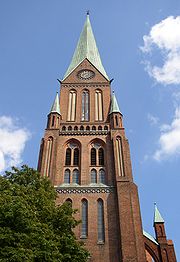
Schwerin Cathedral
Encyclopedia


Obotrites
The Obotrites , also commonly known as the Obodrites, Abotrites, or Abodrites, were a confederation of medieval West Slavic tribes within the territory of modern Mecklenburg and Holstein in northern Germany . For decades they were allies of Charlemagne in his wars against Germanic Saxons and Slavic...
, established by Henry the Lion
Henry the Lion
Henry the Lion was a member of the Welf dynasty and Duke of Saxony, as Henry III, from 1142, and Duke of Bavaria, as Henry XII, from 1156, which duchies he held until 1180....
, to Schwerin from Mecklenburg
Mecklenburg
Mecklenburg is a historical region in northern Germany comprising the western and larger part of the federal-state Mecklenburg-Vorpommern...
in the late 12th century. At first a timber construction served the city as a place of worship. The foundation stone of the cathedral of the former Prince-Bishopric of Schwerin was laid in 1172. After a construction period of seventy-six years, the cathedral was consecrated in 1248. The proto-cathedral is now a Lutheran
Evangelical Lutheran Church of Mecklenburg
The Evangelical Lutheran Church of Mecklenburg is a Lutheran church in the German state of Mecklenburg-Vorpommern, serving the citizens living in Mecklenburg. The seat of the Landesbischof is the state capital Schwerin with Schwerin Cathedral as the principal church...
church.
In 1222 Count Henry of Schwerin had returned from a crusade with the Reliquary of the Holy Blood, an alleged drop of Christ's blood contained in a jewel. This was placed in the cathedral, and caused it to become a place of pilgrimage.
A number of great churches served as models for Schwerin Cathedral
Cathedral
A cathedral is a Christian church that contains the seat of a bishop...
: the Marienkirche in Lübeck
Lübeck
The Hanseatic City of Lübeck is the second-largest city in Schleswig-Holstein, in northern Germany, and one of the major ports of Germany. It was for several centuries the "capital" of the Hanseatic League and, because of its Brick Gothic architectural heritage, is listed by UNESCO as a World...
, the Nikolaikirche in Stralsund
Stralsund
- Main sights :* The Brick Gothic historic centre is a UNESCO World Heritage Site.* The heart of the old town is the Old Market Square , with the Gothic Town Hall . Behind the town hall stands the imposing Nikolaikirche , built in 1270-1360...
and the cathedral of Ratzeburg
Ratzeburg
Ratzeburg is a town in Schleswig-Holstein, Germany. It is surrounded by four lakes—the resulting isthmuses between the lakes form the access lanes to the town. Ratzeburg is the capital of the Kreis of Lauenburg.-History:...
.
During the 14th century the nave and transept were completed, as well as the chapter buildings. At the end of the 15th century the cloister on the north side was finished.
The tower, 117.5 metres high, was constructed between 1889 and 1893.
[Schwerin Dom:http://www.meiser-immobilien.de/images/Schweriner%20Dom.jpg
[Schwerin Crucifix:http://www.dorfkirchen.de/pictures/der_dom3.jpg

